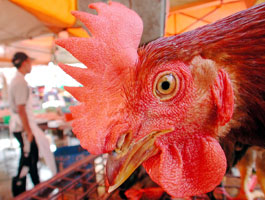
Photo: AP/Wideworld
Introduction by Tom Engelhardt
“Follow that chicken” is not one of the more inspiring lines in the history of detective fiction, nor one of the more frightening in the genre of horror. It’s perhaps on the level of that classic grade-Z sci-fi film, Night of the Lepus, in which the giant, rampaging, mutant rabbits were just… well, big bunnies. And yet, don’t be fooled, the chicken, probably first domesticated in Southeast Asia some 8,000 years ago, might prove the death of many of us, and for its possible depredations, we are painfully unprepared.
In 1918, a flu epidemic emerged from the trenches of World War I’s Western Front — essentially the war?s equivalent of the slums — and swept across the world (twice) ridding it of somewhere between 25 million and 100 million human beings (the equivalent in today’s population terms of possibly upwards of a billion people). There have been flu pandemics since, but none faintly on such a scale. For nearly a decade, epidemiologists, public health officials, and veterinary researchers — by now, in fact just about the whole global medical/scientific community — have been warning that such a new pandemic is a frightening possibility, if not a near certainty. At the same time, some of them have been performing prodigious genetic detective work as a mutant flu virus, H5N1, has lodged in the systems of wild fowl in southern China, moved into massed domestic fowl populations nearby, and begun to spread to human beings; all the while still genetically evolving in birds (domestic and wild), swine, and even perhaps people, “looking for” the means to leap not just from bird to bird, or bird to swine, or even from bird to human, but from human to human at a staggering rate.
Nothing could more quickly remind us that we humans are part of nature than a flu pandemic; yet three quite unnatural changes in our world have drastically increased the danger of such a pandemic. A livestock revolution has gathered domestic birds together — think Tyson chickens — onto giant corporate farms in prodigious numbers, clustering them into what are essentially giant bird slums, where any new disease is guaranteed to spread more easily. Meanwhile, throughout the third world, impoverished human beings have been gathering in far greater urban concentrations than anything imaginable a century ago, and any of these are potential hatcheries for a pandemic. Finally, globalization and global air travel have made the spread of a pandemic, once started, almost instantaneous. In the meantime, H5N1, spreads by an older set of air paths — avian migration routes — having just made it to Russia. And we wait.
What makes this an especially dangerous situation in the U.S. is that the Bush administration has largely chosen to redirect its public-health budget to preparations for “biowar” possibilities — smallpox, Ebola Fever, and the like — which may never endanger us, while scanting the kind of biowar (think Hitchcock’s The Birds, not Osama bin Laden) that is actually likely to do so. Between the administration’s priorities and Big Pharma’s urge to go for the profits — flu shots are unprofitable products — America’s public health structure is in increasingly woeful shape and certainly, despite endless warnings about what might come, in no shape at all to deal with a nationwide flu pandemic.
All of this, by the way, I know only because Mike Davis has just published a must-read, brief new book, Monster at our Door, The Global Threat of Avian Flu, a scientific detective story, a tale of potential horror, and a sociological thriller about our 21st century world. This is a situation with which we should all be acquainted. Even the President evidently belated agrees. Along with Alexander II: The Last Great Tsar (about which I won’t even speculate) and a history of salt, he’s taken John M. Barry’s account of the 1918 flu pandemic, The Great Influenza off to Crawford to read. Maybe I should send a copy of the Davis book down to Crawford as well and Cindy Sheehan could present it to him at their meeting.
Recently, avian flu, which for some years had flown below the headlines and nested on the inside pages of our newspapers, has hit the front-page. (On this issue, as Davis points out, the New York Times has been especially good.) The latest headlines — about a potential vaccine for this possible pandemic — undoubtedly caused a collective sigh of relief. Unfortunately, relief is not actually in sight as Mike Davis explains below, offering his latest update on the monster at our door.
Has Time Run Out?
The Coming Avian Flu Pandemic
By Mike DavisDeadly avian flu is on the wing.
The first bar-headed geese have already arrived at their wintering grounds near the Cauvery River in the southern Indian state of Karnataka. Over the next ten weeks, 100,000 more geese, gulls, and cormorants will leave their summer home at Lake Qinghai in western China, headed for India, Bangladesh, Myanmar, and, eventually, Australia.
An unknown number of these beautiful migrating birds will carry H5N1, the avian flu subtype that has killed 61 people in Southeast Asia and which the World Health Organization (WHO) fears is on the verge of mutating into a pandemic form like that which killed 50 to 100 million people in the fall of 1918. As the birds arrive in the wetlands of South Asia, they will excrete the virus into the water where it risks spreading to migrating waterfowl from Europe as well as to domestic poultry. In the worst-case scenario, this will bring avian flu to the doorstep of the dense slums of Dhaka, Kolkata, Karachi, and Mumbai.
The avian flu outbreak at Lake Qinghai was first identified by Chinese wildlife officials at the end of April. Initially it was confined to a small islet in the huge salt lake, where geese suddenly began to act spasmodically, then to collapse and die. By mid-May it had spread through the lake’s entire avian population, killing thousands of birds. An ornithologist called it “the biggest and most extensively mortal avian influenza event ever seen in wild birds.”
Chinese scientists, meanwhile, were horrified by the virulence of the new strain: when mice were infected they died even quicker than when injected with “genotype Z,” the fearsome H5N1 variant currently killing farmers and their children in Vietnam.
Yi Guan, leader of a famed team of avian flu researchers who have been fighting the pandemic menace since 1997, complained to the British Guardian in July about the lackadaisical response of Chinese authorities to the unprecedented biological conflagration at Lake Qinghai.
“They have taken almost no action to control this outbreak. They should have asked for international support. These birds will go to India and Bangladesh and there they will meet birds that come from Europe.” Yi Guan called for the creation of an international task force to monitor the wild bird pandemic, as well as the relaxation of rules that prevent the free movement of foreign scientists to outbreak zones in China.
In a paper published in the British science magazine Nature, Yi Guan and his associates also revealed that the Lake Qinghai strain was related to officially unreported recent outbreaks of H5N1 among birds in southern China. This would not be the first time that Chinese authorities have been charged with covering up an outbreak. They also lied about the nature and extent of the 2003 SARS epidemic, which originated in Guangdong but quickly spread to 25 other countries. As in the case of SARS’ whistleblowers, the Chinese bureaucracy is now trying to gag avian-flu scientists, shutting down one of Yi Guan’s laboratories at Shantou University and arming the conservative Agriculture Ministry with new powers over research.
Meanwhile, as anxious Indian scientists monitor bird sanctuaries throughout the subcontinent, H5N1 has spread to the outskirts of Lhasa, the capital of Tibet; to western Mongolia; and, most disturbingly, to chickens and wildfowl near the Siberian capital of Novosibirsk.
Despite frantic efforts to cull local poultry, Russian Health Ministry experts have expressed pessimism that the outbreak can be contained on the Asian side of the Urals. Siberian wildfowl migrate every fall to the Black Sea and southern Europe; another flyway leads from Siberia to Alaska and Canada.
In anticipation of this next, and perhaps inevitable, stage in the world journey of avian flu, poultry populations are being tracked in Moscow; Alaskan scientists are studying birds migrating across the Bering Straits, and even the Swiss are looking over their shoulders at the tufted ducks and pochards arriving from Eurasia.
H5N1’s human epicenter is also expanding: in mid-July Indonesian authorities confirmed that a father and his two young daughters had died of avian flu in a wealthy suburb of Jakarta. Disturbingly, the family had no known contact with poultry and near panic ensued in the neighborhood as the press speculated about possible human-to-human transmission.
At the same time, five new outbreaks among poultry were reported in Thailand, dealing a terrible blow to the nation’s extensive and highly-publicized campaign to eradicate the disease. Meanwhile, as Vietnamese officials renewed their appeal for more international aid, H5N1 was claiming new victims in the country that remains of chief concern to the WHO.
The bottom line is that avian influenza is endemic and probably ineradicable among poultry in Southeast Asia, and now seems to be spreading at pandemic velocity amongst migratory birds, with the potential to reach most of the earth in the next year.
Each new outpost of H5N1 — whether among ducks in Siberia, pigs in Indonesia, or humans in Vietnam — is a further opportunity for the rapidly evolving virus to acquire the gene or even simply the protein mutation that it needs to become a mass-killer of humans.
This exponential multiplication of hot spots and silent reservoirs (as among infected but asymptomatic ducks) is why the chorus of warnings from scientists, public-health officials, and finally, governments has become so plangently insistent in recent months.
The new U.S. Health and Human Services Secretary Mike Leavitt told the Associated Press in early August that an influenza pandemic was now an “absolute certainty,” echoing repeated warnings from the World Health Organization that it was “inevitable.” Likewise Science magazine observed that expert opinion held the odds of a global outbreak as “100 percent.”
In the same grim spirit, the British press revealed that officials were scouring the country for suitable sites for mass mortuaries, based on official fears that avian flu could kill as many as 700,000 Britons. The Blair government is already conducting emergency simulations of a pandemic outbreak (“Operation Arctic Sea”) and is reported to have readied “Cobra” — a cabinet-level working group that coordinates government responses to national emergencies like the recent London bombings from a secret war room in Whitehall — to deal with an avian flu crisis.
Little of this Churchillian resolve is apparent in Washington. Although a sense of extreme urgency is evident in the National Institutes of Health where the czar for pandemic planning, Dr. Anthony Fauci, warns of “the mother of all emerging infections,” the White House has seemed even less perturbed by migrating plagues than by wanton carnage in Iraq.
As the President was packing for his long holiday in Texas, the Trust for America’s Health was warning that domestic preparations for a pandemic lagged far behind the energetic measures being undertaken in Britain and Canada, and that the administration had failed “to establish a cohesive, rapid and transparent U.S. pandemic strategy.”
That increasingly independent operator, Senate majority leader Bill Frist (R-Tenn.), had already criticized the administration in an extraordinary (and under-reported) speech at Harvard at the beginning of June. Referring to Washington’s failure to stockpile an adequate supply of the crucial anti-viral oseltamivir (or Tamiflu), Frist sarcastically noted that “to acquire more anti-viral agent, we would need to get in line behind Britain and France and Canada and others who have tens of millions of doses on order.”
The New York Times on its July 17 editorial page, a May 26 special issue of Nature and the July/August issue of Foreign Affairs have also hammered away at Washington’s failure to stockpile enough scarce antivirals — current inventories cover less than 1% of the U.S. population — and to modernize vaccine production. Even a few prominent Senate Democrats have stirred into action, although none as boldly as Frist at Harvard.
The Department of Health and Human Services, in response, has sought to calm critics with recent hikes in spending on vaccine research and antiviral stockpiles. There has also been much official and media ballyhoo about the announcement of a series of successful tests in early August of an experimental avian flu vaccine.
But there is no guarantee that the vaccine prototype, based on a “reverse-genetically-engineered” strain of H5N1, will actually be effective against a pandemic strain with different genes and proteins. Moreover, trial success was based upon the administration of two doses plus a booster. Since the government has only ordered 2 million doses of the vaccine from pharmaceutical giant Sanofi Pasteur, this may provide protection for only 450,000 people. As one researcher told Science magazine, “it’s a vaccine for the happy few.”
At the least, gearing up for larger-scale production will take many months and production itself is limited by the antiquated technology of vaccine manufacture which depends upon a vulnerable and limited supply of fertile chicken eggs. It would also likely mean the curtailment of the production of the annual winter flu vaccine that is so often a lifesaver for many senior citizens.
Likewise, Washington’s new orders for antivirals, as Senator Frist predicted, will have to wait in line behind the other customers of Roche’s single Tamiflu plant in Switzerland.
In short, it is good news that the vaccine tests were successful, but that does little to change the judgment of the New York Times that “there is not enough vaccine or antiviral medicine available to protect more than a handful of people, and no industrial capacity to produce a lot more of these medicines quickly.”
Moreover, the majority of the world, including all the poor countries of South Asia and Africa where, history tells us, pandemics are likely to hit especially hard, will have no access to expensive antivirals or scarce vaccines. It is even doubtful whether the WHO will have the minimal pharmaceuticals to respond to an initial outbreak.
Recent theoretical studies by mathematical epidemiologists in Atlanta and London have raised hopes that a pandemic might be stopped in its tracks if 1 to 3 million doses of oseltamivir (Tamiflu) were available to douse an outbreak in a failsafe radius around the early cases.
After years of effort, however, the WHO has only managed to inventory about 123,000 courses of Tamiflu. Although Roche has promised to donate more, the desperate rush of rich countries to accumulate Tamiflu will be certain to undercut the World Health Organization’s stockpile.
As for a universally available “world vaccine,” it remains a pipe-dream without new, billion-dollar commitments from the rich countries, above all the United States, and even then, we are probably too late.
“People just don’t get it,” Dr. Michael Osterholm, the outspoken director of the Center for Infectious Disease Research and Policy at the University of Minnesota recently complained. “If we were to begin a Manhattan Project-type response tonight to expand vaccine and drug production, we wouldn’t have a measurable impact on the availability of these critical products to sufficiently address a worldwide pandemic for at least several years.”
“Several years” is a luxury that Washington has already squandered. The best guess, as the geese head west and south, is that we have almost run out of time. As Shigeru Omi, the Western Pacific director of WHO, told a UN meeting in Kuala Lumpur in early July: “We’re at the tipping point.”
Mike Davis is the author of the just published Monster at our Door, The Global Threat of Avian Flu (The New Press) and the forthcoming Planet of Slums (Verso).
Copyright 2005 Mike Davis
This piece first appeared at Tomdispatch.com.














